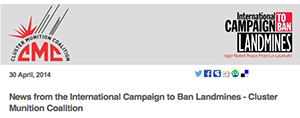08 July 2008
Update from the UN Convention on Conventional Weapons (CCW)
The second day of the CCW GGE maintained its slow pace and sense of confusion over the purpose and direction of the work.The Japanese Friend of the Chair held a brief session on the application of IHL to cluster munitions on the basis of his proposed text on the protection of civilians. Discussions followed the same pattern as the previous day with Canada, France, Germany and Norway noting that the key question was to determine which cluster munitions might be prohibited or restricted and which might not and that until it was clear what the definitions and prohibitions were going to be, a discussion on application of IHL would be difficult. India, Pakistan and Russia opposed any sort of prohibition and any attempt to differentiate between types of cluster munitions, especially on the basis of technology. The US stated that while there could not be consensus on a complete ban, there would likely be some form of restrictions or prohibitions on certain types of cluster munitions. New Zealand and Switzerland set out articulate and well-developed arguments underpinning their concerns about the potential for this discussion to undermine existing IHL, which as they noted yesterday are now linked to the need to protect the high standard set by the CCM. Switzerland suggested that if IHL were to be mentioned in a new protocol on cluster munitions it should simply be a brief reference to the application of all IHL rules, along the lines of the provision in Amended Protocol II on mines. In response to US questioning of the rationale behind such concerns, Canada supported by France, Germany and Norway explained that while existing IHL is clear and applies to all weapons so does not need to be outlined selectively in a protocol, if prohibitions and restrictions were developed on certain cluster munitions these would constitute new rules of IHL and would have to be set out separately.The afternoon was devoted to victim assistance with a plenary session followed by informal consultations convened by Markus Reiterer as Friend of the Chair. Encouragingly, several CCM adopters pushed for maintaining in any new instrument the high standard set on VA in Dublin. Canada was particularly strong arguing compellingly that the provisions on VA in the CCM were vitally important and based on lessons learned and also noting that cluster munition victims are not just from ERW but also from the time of use. (Incidentally Republic of Korea noted in its opening statement on Monday that it was concerned about impact during and after attacks.) While CCM adopters supported the text on victim assistance, Russia, China, Israel, India, Pakistan called for a return to Protocol V language on VA and raised questions about duplication of effort and mechanisms. Israel in particular questioned the human rights approach as "requiring more consideration" for inclusion in an I HL instrument. In a discussion on where the responsibility for victim assistance should rest, Russia, China, Pakistan and Syria also called for the text to include an obligation on users of cluster munitions to provide for victim assistance, although this did not receive support from Canada, Germany and the Netherlands who noted the need for national "ownership" of victim assistance. The CMC intervened on VA in support of the Friend's text and this intervention is attached and copied below.In supporting the CCM text proposed by the Friend of the Chair, Norway also took the opportunity to note that it supported a ban on "cluster munitions as a category of weapons", somewhat easing concerns from the CMC bench prompted by a Norwegian delegate's interventions in the morning and the previous day.Both the morning and afternoon sessions lasted less than two hours each and there was some confusion on the continually changing programme of work.The news of the day was the "new" US policy on cluster munitions leaked via an AP story late on Monday night. The policy (do nothing except export existing cluster munitions until 2018 and then adopt a 1% dangerous duds failure rate for cluster munitions) is unlikely to assist in pushing work forward in the CCW given that India, Pakistan, Russia, Brazil and others have explicitly ruled out a technology based approach. A scheduled lunchtime side event by US cluster munition producer Textron will not help this dynamic. The CMC press release on the US policy was circulated yesterday.Overall it is becoming more and more difficult to see a meaningful way ahead for the CCW's work on cluster munitions. The instinct for Canada, France, Germany and others appears to be that something in the CCW is better than nothing. But a new Protocol that does nothing to address the humanitarian concern and that risks undermining existing rules of IHL, competing with the high standard set by the CCM and providing a convenient alternative for states that are wavering about signing in Oslo would clearly be worse than nothing. While there are several weeks of discussions and much positioning to come in the CCW this year, looking ahead to the outcome in November there are three scenarios that might allow compatibility with the Oslo Process:1) An end to discussions on a new protocol on cluster munitions with perhaps a commitment to renew focus on this in the implementation of Protocol V;2) A roll over of the current mandate to continue discussions next year on a new instrument on cluster munitions, while the CCM is busy entering into force;3) Agreement in November on a brief protocol that says very little, but what it does say is consistent with the CCM and so does not conflict with it.CMC Intervention on Victim Assistance


